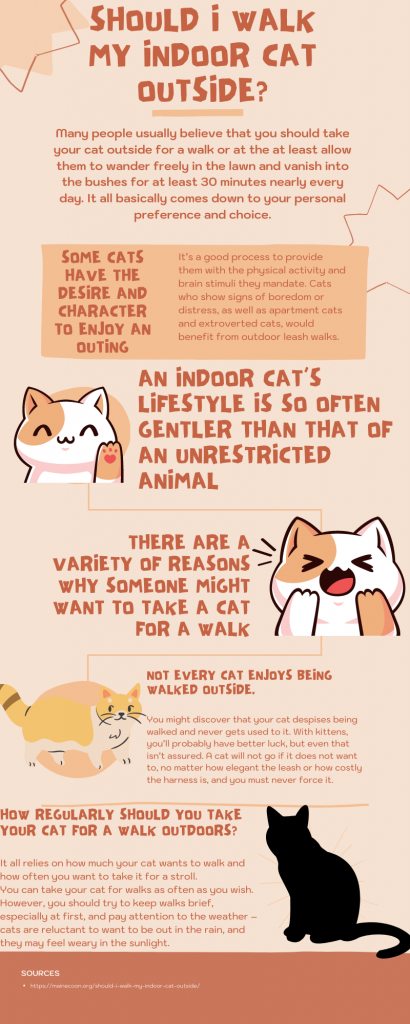Many cat owners are indecisive about whether or not to take their cat for a walk outside. When you think about it, today's indoor cat is similar to a tiger who has been deprived of his natural freedom. Its forefathers hunted mice in the deserts and forests.
Finally, they made their way into our living rooms, and while people went for walks with their dogs, cats were isolated from the rest of world.
Many people usually believe that you should take your cat outside for a walk or at the at least allow them to wander freely in the lawn and vanish into the bushes for at least 30 minutes nearly every day. It all basically comes down to your personal preference and choice.
Jump to:
- Some cats have the desire and character to enjoy an outing
- An indoor cat's lifestyle is so often gentler than that of an unrestricted animal
- There are a variety of reasons why someone might want to take a cat for a walk
- When You're exposing your cat to outside risks
- Not every cat enjoys being walked outside.
- How regularly should you take your cat for a walk outdoors?
- What breeds of cats can be walked on a leash?
- Is walking a cat on a leash harsh?
- Allow your cat to investigate the harnesses and leashes.
- Teach your cat with modest indoor walks after it is comfortable wearing the harness.
- Patience is crucial in this situation.
- Conclusion
Some cats have the desire and character to enjoy an outing

It's a good process to provide them with the physical activity and brain stimuli they mandate. Cats who show signs of boredom or distress, as well as apartment cats and extroverted cats, would benefit from outdoor leash walks. Overgrooming, urinating outside the litter box, and destructive behaviors around the house are common signs of stress in cats.
If your cat spends a lot of time staring out the window, an outdoor walk would be wonderful. And if they rush for the doorway whenever it opens, they're prepared for a leash walk outside.
An indoor cat's lifestyle is so often gentler than that of an unrestricted animal

It's no secret that an outdoor cat on its own has numerous hazards on the harsh streets—or even in the countryside. An indoor cat does not have to deal with the rising number of vehicles, pollutants, infections, and cases of animal abuse that an outdoor cat does. As a result, most pet specialists advise parents to keep their cat’s home. But it's not always simple.
There are a variety of reasons why someone might want to take a cat for a walk

It's possible that it's because they have an indoor cat that wouldn't be able to go outside otherwise. This is very popular in towns or urban regions where cats are roaming outside alone could be fatal. Someone could potentially reside in a region where predators like coyotes are a threat. Allowing cats with disabilities, chronic illnesses, or those recovering from surgery outside while monitored may be beneficial.
Owners may simply desire company when they go for a stroll, or they may be travelling with the cat and unable to leave it all alone. Walking your cat around a neighborhood can also assist the feline become familiarized to its environment before unleashing it on its own.
When You're exposing your cat to outside risks
It can be highly distressing for them. It can rapidly become overwhelming if they aren't exposed to road noises, dogs barking, or the odors of the outside world. When cats are overworked, they may let go of the leash and flee. This will also be highly upsetting for the owner.
No products found.
You'll need to ensure your cat is updated on vaccinations and flea and worm treatments. It's easy to overlook these risks if you have an indoor cat, but letting them outside risks them to potential diseases and parasites. It's also a smart option to have your cat chipped.
Not every cat enjoys being walked outside.

You might discover that your cat despises being walked and never gets used to it. With kittens, you'll probably have better luck, but even that isn't assured. A cat will not go if it does not want to, no matter how elegant the leash or how costly the harness is, and you must never force it.
People will stare at you strangely, and they may laugh or make comments. This may not bother you at first, but it can quickly become annoying.
While taking cats outdoors might be regarded as extending their territories, it can be unpleasant for some cats, especially if they can see or smell other pets. Most cats cannot be walked in the same manner that a dog can. Cats are often slower, stopping to investigate and explore. It means you might not be able to travel very far or cover a lot of ground.
You'll need to get a good and dependable collar or leash. If a cat loses its harness, it is in grave danger of being harmed or becoming separated from its owner. Some people think walking a cat is peculiar, but others don't. In most cities, it's still unusual, but with so many of us now living in flats, it'll become more prevalent.
How regularly should you take your cat for a walk outdoors?

It all relies on how much your cat wants to walk and how often you want to take it for a stroll.
You can take your cat for walks as often as you wish. However, you should try to keep walks brief, especially at first, and pay attention to the weather – cats are reluctant to want to be out in the rain, and they may feel weary in the sunlight.
A walking regimen can be beneficial. Cats who like to go outside may grow irritable during the day. On regular walks, you don't really want your cat making the decisions.
What breeds of cats can be walked on a leash?
You may try to get any cat to walk on a harness, but some breeds are more accepting of the idea than the others. Bengals, Burmese, Siamese, and Savannah cats are among the liveliest cats, as are Abyssinian cats.
No products found.
Teach them to walk while they're a kitten onwards, as you'll have a better chance of seeing different breeds when they're younger.
Is walking a cat on a leash harsh?

Many people, including some veterinarians and animal welfare organizations, believe that you should not walk your cat on a lead. However, some owners of adventurous cats, think it's a fantastic concept. Then there are many in the middle, including some vets, who believe it has its uses in specific circumstances.
Not considered necessary, however you should check that the lead is properly fitted. A harness is a better option than a leash since it is more comfortable. Leads that are ill-fitting or insecure may release unintentionally, letting your cat to escape.
The usual rule of thumb for a secure fit under the harness is 2 fingers — slightly more or less, as you'll need to tighten or loosen it. Stop immediately if your cat does not like being put in a collar or on a leash, or if it demonstrates any nervousness or hostility.
It's worth remembering that roaming with a cat is not the same as walking a dog. Walking and harnesses aren't always as easy for cats as they are for dogs. Cats, as we all know, do not like to be restrained. The best thing you can do is teach and educate your cat for such new experience in the great outdoors. Because cats wiggle, be careful to wear a harness.
The finest harness for your cat is one that appropriately distributes pressure throughout their body and has safety features to prevent your cat from slipping out.
Allow your cat to investigate the harnesses and leashes.
Make sure you have a lot of goodies on hand. Give them a snack every time they sniff or contact the equipment. Wrap the harness around your cat's neck and allow him to play with it. Reward the behavior with a snack once again. Once the cat is happy with his new outfit, put him on the leash.
Treats should be available at all times. This will highlight the importance of wearing a harness. You could also use relaxing fragrances to help him adjust to his new surroundings. You won't need much, just a spritz or so.
Teach your cat with modest indoor walks after it is comfortable wearing the harness.

Allow your cat to roam freely throughout the house while carrying the harnesses and carrying the leash. Give him snacks once again to reinforce the pleasant relationship. If the cat refuses to move or has difficulty doing so, take a pause until he feels more at ease.
It's vital that you improve your skills with this instruction. Its time taking to get used to a new environment. While it is simpler a kitten to do this, an adult cat can also be trained. Your cat will finally be ready for an outdoor leash stroll after all of this indoor preparation.
It's best to take your first walk in a relatively private outdoor space. A decent place to start is in your own garden. Before going any further, make sure your cat is comfy with that as well. Most importantly, regularly take your cat for a leashed walk outside and enjoy the time. It's the perfect time for your cat to get out of the house and explore the outside area.
You'll also need to make sure your cat is safe. Fleas, heartworm, and intestinal worms are more common in leashed kitties. On your cat, be using a safe heartworm preventative. Use a heartworm preventive as well.
Patience is crucial in this situation.

Rather than yanking your cat to obedience and forcing him to walk, simply praise the desired behavior. When the cat decides to walk alongside you, make sure to reward him with plenty of food and love. The idea is to let your cat move about freely while being close enough just to pick them up immediately.
This implies that the harness on your kitty should have flexible straps that go around the torso and chest. Fabric wraps or strap harness can be used based on your cat's fur thickness and type of body. Wrap and strap harnesses can be difficult to wrap around a puffy cat, and strap harnesses can slide off a slender cat.
Fit the equipment on your cat and let it walk all around home for a bit to start training them for an open outing. You should also make sure your cat has up-to-date immunizations and a clear identification tag.
There are many decent cat leashes on the market; however, avoid adjustable leashes. Retractable leashes put you further away from your cat and offer you less command. Cats who are relaxed may allow you to put that on them right away, while others will want to sniff and explore it primarily.
In the first few steps, you may want to use goodies to help your cat link the harness to something pleasant. Whenever the cat is distracted or sitting in your lap, you can place the harness on their fur to get a feel for it.
When you're ready, slide them in smoothly and swiftly, then let the cat walk around with it on. Keep it loose at this time and allow them to have a feel for having to wear it.

Conclusion

Cats enjoy being outside, and it can be agonizing to see your feline glancing helplessly out the window at the sky and breezes. If properly trained, your cat can be carried on a leash, allowing you and your feline companion to embark on countless excursions. However, if you've ever tried to walk your cat on a leash, you'll know that the training isn't always straightforward, and that enjoyable outing can come off looking such as this.
If both you and pet cat determine that strolling on a leash is not for you both, there are also plenty of alternatives. You might use a break free fence or escape-proof your garden to give your cat space to roam outside. There are many of indoor hobbies and games to keep your cat entertained and stimulated.




